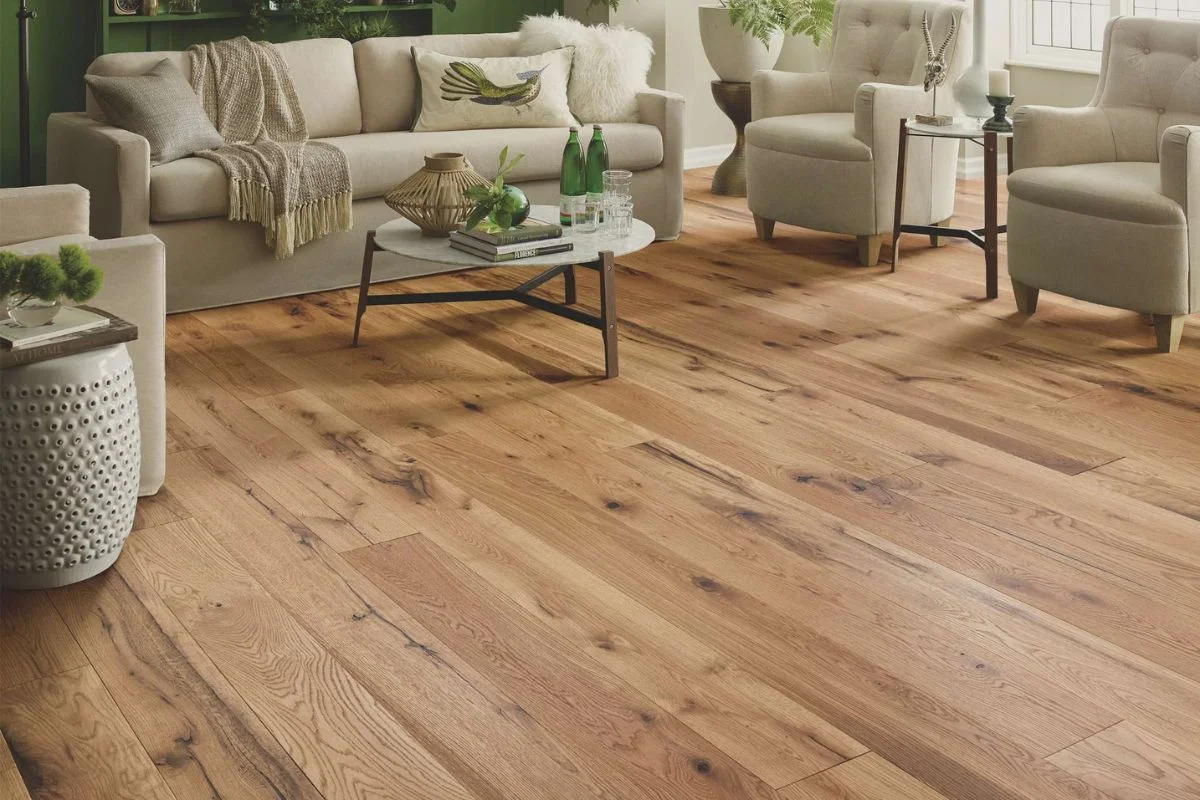Blog
 Selecting the perfect wood flooring for your home is an exciting yet crucial decision that can greatly influence the overall look, feel, and ambiance of your living space. Wood flooring not only adds warmth and character to a room but also enhances its aesthetic appeal and value. With a wide array of options available in terms of wood species, colors, finishes, and installation methods, the process of choosing the right wood flooring can seem daunting.
In this guide, we’ll delve into the various tips and considerations that will help you navigate the world of wood flooring with confidence and ease. Whether you’re renovating your current space or building your dream home, understanding the factors that influence your wood flooring choice is essential in creating a living environment that reflects your style, personality, and practical needs.
Selecting the perfect wood flooring for your home is an exciting yet crucial decision that can greatly influence the overall look, feel, and ambiance of your living space. Wood flooring not only adds warmth and character to a room but also enhances its aesthetic appeal and value. With a wide array of options available in terms of wood species, colors, finishes, and installation methods, the process of choosing the right wood flooring can seem daunting.
In this guide, we’ll delve into the various tips and considerations that will help you navigate the world of wood flooring with confidence and ease. Whether you’re renovating your current space or building your dream home, understanding the factors that influence your wood flooring choice is essential in creating a living environment that reflects your style, personality, and practical needs.
Brief overview of wood flooring
Wood flooring is a type of flooring material made from natural hardwood or engineered wood planks. It is renowned for its timeless elegance, durability, and ability to add warmth and character to any space. Wood flooring comes in various types, including solid hardwood and engineered wood, each offering unique benefits and characteristics.
Solid hardwood flooring is crafted from a single piece of hardwood and is known for its authenticity, beauty, and longevity. It can be sanded and refinished multiple times, allowing it to maintain its appearance and durability for generations. Engineered wood flooring, on the other hand, consists of multiple layers of wood veneer bonded together with adhesives. It offers enhanced stability and resistance to moisture, making it suitable for installation in areas where solid hardwood may be prone to expansion and contraction.
Wood flooring is available in a wide range of wood species, colors, finishes, and textures, allowing homeowners to customize their floors to match their unique style and preferences. From traditional oak and maple to exotic species like Brazilian cherry and acacia, there is a wood flooring option to suit every taste and design aesthetic.
Installation methods for wood flooring vary depending on the type of flooring chosen and the subfloor conditions. Solid hardwood flooring is typically nailed or stapled down, while engineered wood flooring can be installed using a floating, glue-down, or nail-down method.
Definition of Wood Flooring
Wood flooring refers to a type of flooring material made from natural hardwood or engineered wood. It is characterized by its solid wood planks or engineered wood layers that are installed as a durable and aesthetically pleasing surface for interior spaces.
Both solid hardwood and engineered wood flooring come in a variety of wood species, colors, finishes, and textures, allowing homeowners to choose a flooring option that complements their interior design style and preferences.
Types of wood flooring
Wood flooring comes in various types, each offering unique characteristics and benefits. Here are the main types of wood flooring:
Solid Hardwood Flooring:
- Solid hardwood flooring is made from a single piece of hardwood, such as oak, maple, cherry, or walnut.
- It is known for its authenticity, durability, and timeless beauty.
- Solid hardwood can be sanded and refinished multiple times, allowing it to maintain its appearance and durability for generations.
- It is susceptible to expansion and contraction due to changes in humidity and moisture levels, so it may not be suitable for installation in areas with high moisture, such as basements.
- Engineered wood flooring consists of multiple layers of wood veneer bonded together with adhesives.
- The top layer, or wear layer, is made of real hardwood, while the core layers are typically made of plywood or high-density fiberboard (HDF).
- Engineered wood flooring offers greater stability and resistance to moisture compared to solid hardwood, making it suitable for installation in areas with fluctuating humidity levels.
- It can be installed as a floating floor or glued down, depending on the manufacturer’s recommendations.
- Reclaimed wood flooring is made from salvaged wood that has been reclaimed from old buildings, barns, and other structures.
- It offers a rustic and weathered appearance, with unique character marks such as knots, nail holes, and patina.
- Reclaimed wood flooring is environmentally friendly and adds a sense of history and authenticity to any space.
- Bamboo flooring is made from the fast-growing bamboo plant, which is renewable and sustainable.
- It is highly durable, eco-friendly, and resistant to moisture and insects.
- Bamboo flooring comes in a variety of styles, colors, and finishes, making it a versatile option for modern interiors.
- Cork flooring is made from the bark of the cork oak tree.
- It is naturally resistant to moisture, mold, and mildew, making it an excellent choice for kitchens, bathrooms, and other high-moisture areas.
- Cork flooring is soft underfoot and provides excellent thermal and sound insulation.
Benefits of Wood Flooring
Wood flooring offers a multitude of benefits that make it a popular choice for homeowners and designers alike. Here are some of the key advantages of wood flooring:
Timeless Elegance: Wood flooring adds a touch of timeless elegance and natural beauty to any space. Its warmth, texture, and richness create a welcoming and inviting atmosphere that enhances the overall aesthetics of a room.
Durability and Longevity: High-quality wood flooring is incredibly durable and can withstand heavy foot traffic, making it a long-lasting investment for your home. With proper care and maintenance, wood flooring can last for decades and even centuries, retaining its beauty and charm over time.
Versatility in Design: Wood flooring comes in a wide variety of species, colors, grains, and finishes, allowing homeowners to customize their floors to match their unique style and preferences. Whether you prefer the classic look of oak or the exotic allure of Brazilian cherry, there’s a wood flooring option to suit every taste and design aesthetic.
Increased Home Value: Wood flooring is highly sought after by homebuyers and can significantly increase the resale value of your home. Its timeless appeal and durability make it an attractive feature that adds to the overall appeal and marketability of your property.
Easy Maintenance: Wood flooring is relatively easy to clean and maintain compared to other flooring materials. Routine sweeping, vacuuming, and occasional mopping with a damp cloth are usually all that’s needed to keep wood floors looking their best. Additionally, wood flooring can be sanded and refinished to remove scratches and surface damage, extending its lifespan and beauty.
Eco-Friendly Choice: Wood flooring is a sustainable and environmentally friendly choice for flooring. Many manufacturers use responsibly sourced wood from managed forests, ensuring that forests are replenished and ecosystems are preserved for future generations. Additionally, wood flooring has a lower carbon footprint compared to other flooring materials, making it a more environmentally conscious choice.
Health Benefits: Wood flooring is hypoallergenic and does not harbor dust, pollen, or other allergens like carpeting can. This makes it a healthier option for individuals with allergies or respiratory issues, promoting better indoor air quality and overall well-being.
Choosing the Perfect Wood Flooring
Choosing the perfect wood flooring for your home is a significant decision that can greatly impact the overall look, feel, and value of your living space. With a wide array of options available in terms of wood species, colors, finishes, and styles, it’s important to consider several factors to ensure that you select the option that best suits your needs, preferences, and lifestyle. Here are some key considerations to keep in mind when choosing the perfect wood flooring:
Assess Your Needs and Lifestyle: Consider your lifestyle and the specific needs of your household. Do you have pets or young children who may cause wear and tear on the floors? Are you looking for flooring that can withstand heavy foot traffic in certain areas of your home? Assessing these factors will help you determine the level of durability and resilience your wood flooring needs to have.
Wood Species and Grain Patterns: Different wood species offer unique characteristics in terms of color, grain pattern, and hardness. Oak, maple, cherry, and walnut are popular choices for wood flooring, each with its own distinct appearance and qualities. Consider the aesthetic appeal and durability of different wood species when making your selection.
Color and Finish Options: Wood flooring comes in a variety of colors and finishes, ranging from light natural tones to rich, dark hues. Consider the color palette of your home’s interior decor and choose a wood flooring color that complements your existing furnishings and design scheme. Additionally, explore different finish options, such as matte, satin, or glossy finishes, to achieve the desired look and feel for your space.
Durability and Maintenance Requirements: Evaluate the durability and maintenance requirements of different wood flooring options. Solid hardwood flooring is known for its longevity and can be sanded and refinished multiple times, while engineered wood flooring offers greater stability and resistance to moisture. Consider factors such as ease of maintenance, scratch resistance, and long-term durability when selecting your wood flooring.
Budget Considerations: Determine your budget for wood flooring, including the cost of materials, installation, and any additional accessories or services required. Keep in mind that while solid hardwood flooring may have a higher upfront cost, it can add significant value to your home and may be worth the investment in the long run.
Environmental Considerations: If sustainability is important to you, consider choosing wood flooring that is sourced from responsibly managed forests and certified by organizations such as the Forest Stewardship Council (FSC). Look for wood flooring options that are environmentally friendly and have minimal impact on the ecosystem.
Installation Methods and Compatibility: Consider the installation method and compatibility of wood flooring with your home’s existing subfloor. Solid hardwood flooring is typically nailed or stapled down, while engineered wood flooring can be installed as a floating floor or glued down. Consult with flooring professionals to determine the most suitable installation method for your specific needs.
Maintenance and Care Tips Wood Flooring
Proper maintenance and care are essential for preserving the beauty and longevity of wood flooring. Here are some tips to help you keep your wood floors looking their best:
Regular Cleaning:
- Sweep or vacuum your wood floors regularly to remove dust, dirt, and debris. Use a soft-bristle broom or a vacuum cleaner with a soft brush attachment to avoid scratching the surface.
- For deeper cleaning, use a damp mop with a mild wood floor cleaner specifically formulated for hardwood floors. Avoid using excessive water, as it can damage the wood and cause warping or swelling.
- Place mats or rugs at entryways and high-traffic areas to trap dirt, grit, and moisture before it reaches the wood flooring.
- Use furniture pads or coasters under the legs of heavy furniture and appliances to prevent scratches, dents, and indentations on the wood surface.
- Avoid walking on wood floors with high heels or shoes with sharp edges that can scratch or dent the surface.
- Wipe up spills immediately using a soft, dry cloth to prevent moisture from seeping into the wood and causing damage.
- Use a humidifier during dry seasons to maintain the optimal humidity level in your home and prevent wood flooring from drying out and shrinking.
- Avoid excessive exposure to water or standing water on wood floors, as it can cause warping, cupping, and discoloration.
- Use only recommended wood floor cleaners and avoid using harsh chemicals, ammonia-based cleaners, or abrasive cleaning agents, as they can damage the finish and strip away the protective layer of the wood flooring.
- If necessary, dilute wood floor cleaners according to the manufacturer’s instructions and test them in an inconspicuous area before applying them to the entire floor.
- Use blinds, curtains, or UV-blocking window treatments to minimize exposure to direct sunlight, which can cause fading and discoloration of wood flooring over time.
- Rotate area rugs and furniture periodically to ensure even exposure to sunlight and prevent uneven fading or discoloration of the wood surface.
- Inspect your wood flooring regularly for signs of wear, damage, or scratches. Address any issues promptly to prevent further damage and maintain the beauty of the wood surface.
- Consider refinishing or recoating your wood flooring every few years to restore its luster and protect it from everyday wear and tear
Conclusion
In conclusion, proper maintenance and care are essential for preserving the beauty, durability, and longevity of wood flooring. By following the tips and guidelines outlined in this guide, you can ensure that your wood floors remain in top condition and continue to enhance the aesthetic appeal and value of your home for years to come.




